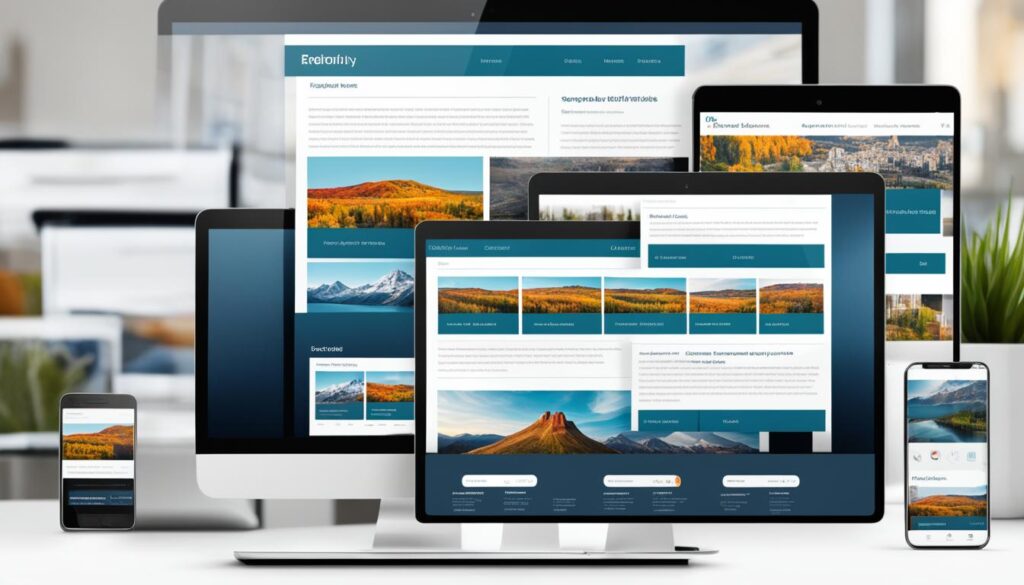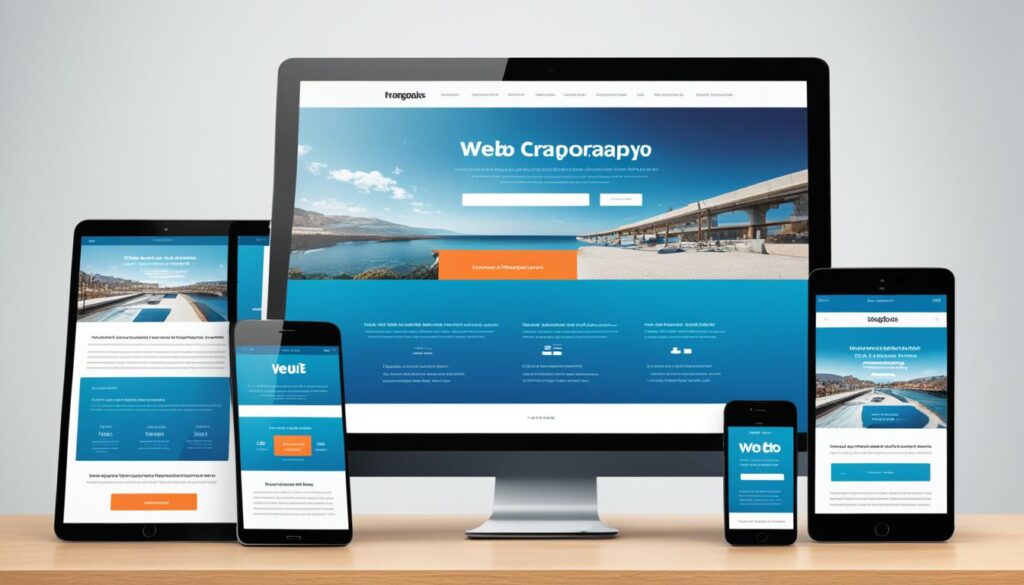Do you know JavaScript was called LiveScript by Netscape at first? It might surprise you to learn this! This name change is just one part of web technology’s long history.
Staying current with the newest web standards is key for developers today. Dr. Terry Felke-Morris’s 10th edition of “Web Development & Design Foundations with HTML5” is a vital guide. It keeps developers up to date with the newest markup languages and techniques.

This edition also highlights the CSS Flexible Layout Module (Flexbox) and CSS Grid Layout. It focuses on Chapter 9’s form layout using these advanced systems.
The book also covers the newest HTML5 elements and attributes. This update helps readers become skilled at making contemporary web pages.
This guide also gets into page layout design and responsive web design. Dr. Felke-Morris added new code samples and case studies. These additions make learning more engaging.
The companion website, webdevfoundations.net, offers flashcards and practice activities. It’s like having a classroom at your fingertips.
Key Takeaways
- Introduction of new layout systems including CSS Flexbox and CSS Grid Layout in the 10th edition.
- Updated and expanded coverage of HTML5 elements and attributes.
- Enhanced focus on page layout design and responsive web design techniques.
- Companion website with review flashcards and hands-on practice activities.
- Resources such as instructor materials with exercise solutions and case solutions.
The 10th edition of “Web Development & Design Foundations with HTML5” is necessary. It’s essential for both newcomers and those with more experience. It ensures everyone stays ahead in front-end development and web standards.
Introduction to Web Development and Design
The 9th edition of “Web Development & Design Foundations with HTML5” by Dr. Terry Ann Felke-Morris is key for both students and pros.
It deepens into web development and design, highlighting user experience and typography. Its goal is to help in making websites that are not only functional but also enjoyable to visit.
What is Web Development?
Web development includes making websites for the internet or an intranet. It starts from coding in HTML, CSS, and JavaScript to handling server-side scripts, databases, and programming for web applications.
The book begins with simple HTML and CSS. It makes sure you understand the basics before moving on to things like making websites that work well on any screen size and adding interactive features.
The Importance of Web Design
Dr. Felke-Morris stresses how important web design is in making sites that look good and work well. Design impacts users the moment they see your site, and it keeps them coming back.
She looks closely at using the right fonts to make text easy to read and engaging. She shows how choosing the right font can change how people feel about a website.
Combining Development and Design
The book emphasizes the power of bringing development and design together well. The 9th edition covers new content on HTML5 and CSS, suggesting the best ways to design modern web pages.
Dr. Felke-Morris advises keeping the structure of your website separate from how it looks (HTML from CSS). This helps keep your website’s code clean, making it easier to maintain.
As well, the book talks about up-to-date techniques like making websites that work well on any screen size and designing for mobile devices first.
These all help in creating websites that are both easy to use and nice to look at, improving the overall user experience.
| Attribute | Details |
|---|---|
| Price | $224.98 |
| Edition | 9th |
| Coverage | HTML5, HTML5.1, Mobile Devices Design, Responsive Design, CSS Grid |
| Author | Terry Ann Felke-Morris |
| Pages | 720 |
| ISBN | 9780134801148 |
| Publication Date | February 2nd, 2018 |
HTML5 Basics
HTML5 is the heart of modern web development. It provides a stronger framework for web projects. This makes your site more organized and richer in content.
Overview of HTML5 Elements
HTML5 brings new elements for a better-structured site. <article>, <section>, and <nav> are some. They improve your code quality, and site performance, and help screen readers understand better.
You can learn more about this in Terry Felke-Morris’s book, “Web Development and Design Foundations with HTML5″. It’s priced at $224.98.
New Features in HTML5
New features in HTML5 make developing websites easier. For instance, it makes creating web forms and handling media simpler. Now you can add audio or video directly to your site with tags like <audio> and <video>.
Moreover, HTML5 supports making sites that look good on any device. It uses tools like Flexbox and Grid Layout for better design control. This ensures your visitors get a great viewing experience.
| Feature | Description |
|---|---|
| Semantic Elements | New elements like <article> and <section> help structure the document semantically. |
| Multimedia Support | Direct embedding of media elements using <audio> and <video> tags. |
| Form Enhancements | User-friendly attributes for easier form creation and validation. |
| Responsive Design | Built-in features and layouts like Flexbox and Grid support responsive web design. |
Dr. Felke-Morris has over 25 years of IT experience and many certifications. Her book is great for new and experienced web developers. It focuses on practical skills and applying HTML5 for better site responsiveness and accessibility.
CSS for Styling and Layout
CSS (Cascading Style Sheets) is key in making websites look good and work well. It’s at the core of crafting beautiful and efficient websites.
The 10th edition of “Web Development & Design Foundations” highlights key CSS tools like Flexbox and Grid layouts. These have changed how we think about managing website layouts.
Color and Text Configuration
Color and text are vital in web design and they deeply affect how users experience a website. Using CSS, we control everything about fonts, sizes, and spaces.
This makes sure the text is clear and easy to read on all devices. CSS also helps create color schemes that make websites both eye-catching and consistent.
Layout Systems: Flexbox and Grid
Flexbox and Grid are advanced CSS tools for creating layouts that are both strong and flexible. Flexbox makes it easier to position items in a row or a column.
This allows for designs that change based on the device a site is viewed from. Grid, on the other hand, lets developers work in both rows and columns.
This means they can make intricate web layouts with little effort. Chapter 9 in the 10th edition shows how to put these systems to work, making forms and layouts fine-tuned.
| Layout System | Overview |
|---|---|
| Flexbox | Provides a one-dimensional layout model, optimizing space distribution and alignment. |
| Grid | Offers a two-dimensional grid layout, enabling more complex and precise web designs. |
| Usage in the 10th Edition | Chapter 9 covers practical examples and exercises. |
Responsive Design Techniques
For websites to work on any device, we need to use responsive design. This means using media queries and flexible grids. The 10th edition includes the latest ways to make this happen.
With updated code samples and practice exercises, it helps learners master making websites that look great everywhere.
Responsive Web Design
Creating websites that look good and work well on all devices is a must.
The 10th edition of “Web Development & Design Foundations” explains why mobile views are so important. We learn about the key parts of making a site respond well to different screens.
Mobile-First Approach
Starting with the smallest screen is what a mobile-first approach is about.
Then, we make the site better for larger screens. This method, shared in Chapter 7, ensures all users can easily see and use the site. It makes sure the site is up-to-date with how we use the web today.

Media Queries
Media queries help us style sites for different devices. They let us set rules that change based on a device’s features. This skill, taught in the book, makes sure a site looks good on any device. It keeps our sites following the latest design and use rules.
Flexible Images and Text
Images and text that can change with screens are key to responsive design.
We use special coding to make them adjust. This makes sure everything looks nice and is easy to read, no matter the device. It’s all about making your visit smooth and enjoyable.
The table below lists key aspects of responsive web design:
| Element | Description | Importance |
|---|---|---|
| Mobile-First | Start small, then get bigger | Ensures everyone can easily use the site |
| Media Queries | Change layout based on device | Makes the site look good on all devices |
| Flexible Images and Text | Adjusts for different screen sizes | Keeps content looking great and easy to read |
The book’s 10th edition offers updated lessons on responsive web design. It helps students and teachers learn how to build sites that work well and look great on all devices. These skills are essential for modern web development.
Accessibility in Web Design
Putting accessibility at the core of web development is key to making websites everyone can enjoy. It helps those with disabilities browse and use sites easily. This is done by following web design rules and using HTML5 as a foundation.
Importance of Accessibility
Accessibility is vital for *responsive web design*. It allows all people, even those with disabilities, to smoothly use websites. Web standards, like those in the 10th edition of Web Development & Design Foundations, ensure everyone can access content.
This level of design uses HTML5 and focuses on being inclusive. It follows set standards to meet the needs of people with various disabilities.
Techniques for Accessible Design
Creating accessible designs involves specific choices during development.
This may include using HTML5 elements to make content easy to understand. The 10th edition also covers CSS Flexbox and Grid for creating flexible, accessible forms.
It’s also important to add text options for things like photos and videos. Adding descriptions helps screen readers explain visuals to those who can’t see them. Guidelines from the W3C can guide you in making a website that’s welcoming to everyone.
| Edition | Focus Areas | Accessibility Features |
|---|---|---|
| 10th Edition | CSS Flexbox, CSS Grid Layout | Responsive form layouts |
| 6th Edition | HTML5, CSS3, Multimedia | Text alternatives, Semantic HTML |
| 9th Edition | JavaScript, E-commerce | Best Practices in Code |
These editions show a move towards better accessibility. They mix *web development with HTML5*, including new layout systems. This creates a more welcoming web experience for everyone.
Cross-Browser Compatibility
Making sure a website looks and works the same on different browsers is key in web development. Even with improved standards, challenges happen when dealing with various browser types.
Challenges with Different Browsers
In the 1990s, browsers like Internet Explorer 4 and Netscape 4 fought to be on top. This caused sites to show differently. Today, browsers follow standards better.
But, some sites still must work on old browsers, making things harder. Accessibility for everyone, including those who use screen readers, is crucial too.
Today, we have many devices, leading to different website performance issues. While many people use just one browser, the range of options is vast.
This is why thorough testing on different browsers is important. Big ones like Chrome, Safari, Firefox, and Opera are popular, but we must also consider browsers like UC Browser and Microsoft Edge.
Testing and Debugging Tips
Starting to think about how your site will work on different browsers early is smart. Some common issues are certain parts not showing as they should. With good planning and testing, most of these issues can be fixed.
Workflow for bug fixes can generally be divided into four phases: Initial planning, Development, Testing/discovery, and Fixes/iteration.
Here’s a guide to make cross-browser testing easier:
- Set a comprehensive ‘Doctype’ for HTML files.
- Apply CSS reset rules to make styling the same everywhere.
- Use libraries and frameworks that work well on different browsers.
In testing, focus on the top five browsers: Google Chrome, Safari, Firefox, UC Browser, and Opera. Include Microsoft Edge too, even though it’s less used.
Online testing services help make the process smoother, ensuring your site works well on all browsers. This improves the user experience and meets your optimization goals.
Web Development and Design Foundations with HTML5
The 10th edition of Web Development & Design Foundations dives into modern web development with HTML5. It’s always up with the latest web standards.
This book focuses on making sure web developers can craft sites that respond well and are easy to use.
It talks about new layout tools,
such as the CSS Flexible Layout Module and CSS Grid Layout, in a chapter called “Responsive Page Layout.” These help developers make sites that look good and work well. The book also covers designing forms that are simple and intuitive with CSS Flexbox and Grid Layout.
The book goes deep into designing web pages and making them work on any device. It includes the latest in HTML5, sample codes, and real-world examples.
The book’s website has extra stuff for studying, like flashcards and chapter resources, which are great for students.
If you want to get your hands dirty, the 6th edition offers lots of practical exercises. These exercises come with clear steps and pictures to guide you. This edition is valuable for both newbies and pros, exploring all the latest web design specs and trends.
| Edition | Focus | New Features |
|---|---|---|
| 10th Edition | Responsive Page Layout, Form Layout with Flexbox and Grid | Updated code samples, case studies, web resources |
| 6th Edition | Hands-on practice exercises, separating HTML structure from CSS styles | Solutions for practice exercises, e-commerce, introduction to JavaScript |
The writer is Dr. Terry Felke-Morris, drawing from her industry and teaching experience. She offers tons of insights and tools for mastering front-end development. Instructor resources like PowerPoint slides and test questions help in teaching from the book.
User Experience and Web Typography
Understanding how user experience (UX) and web typography work together is vital for today’s web designers.
The appearance of text on a page can change how people read and interact with what’s written. It’s key for keeping users engaged and ensuring they enjoy their visit.

Responsive design is crucial for good UX. It uses tools like media queries to adjust content for any screen size. This means fonts and layouts look good no matter if you’re on a big screen or a small one. As a result, everyone can read and use the site comfortably.
Markups like HTML and style sheets like CSS are at the heart of building user-friendly sites. They help organize content and make things look great.
This makes the site easier to understand and more attractive. And it means your site will work and look good on any device.
Various aspects of typography help make a site’s experience top-notch. Here’s what’s important:
- Readability: Pick the right size, space, and color for your text to be easy on the eyes.
- Hierarchy: Use different text styles to lead the reader through your content.
- Accessibility: Make sure everyone, even those with sight issues, can read your site.
- Consistency: Keep your web type the same for a professional and cohesive look.
Getting these things right can change any website into an interactive, welcoming place. It’s all about mixing good design principles with smart use of technology. This blend is the key to making websites that people enjoy being on.
Website Optimization
Focusing on website optimization is key. It ensures your site loads fast and users love it. We’ll talk about why speed matters and tricks to boost performance.
These are based on *web development and design foundations with HTML5*. Making your site work well keeps people interested and your search rankings high.
Importance of Speed
In today’s world, speed is essential, not just a nice-to-have. Research shows people expect sites to load in two seconds. If it’s slower, they’ll likely leave. Working on speed helps keep visitors on both computers and phones engaged.
Techniques for Optimizing Performance
- Minimizing Code: Get rid of extra stuff in your code to make files smaller. This lets them download faster.
- Leveraging Browser Caching: Save often-used files on users’ devices. This way, the site loads quicker when they come back.
- Optimizing Media Files: Use tools to make images and videos smaller without losing quality. This speeds up your site and makes it more *accessible*.
| Optimization Technique | Benefit |
|---|---|
| Minimize Code | Smaller files, quicker downloads |
| Browser Caching | Faster load times for returning visitors |
| Optimize Media Files | Speeds up loads, boosts *accessibility* |
By using these tips, your site can be fast and easy to use. We have over 25 years in IT and many achievements. Let us help your website perform better and offer a great user experience. Stay competitive by focusing on these basic optimization steps.
Conclusion
HTML5 is changing the game in web development, allowing for new tags like header and footer. What’s more, it makes sites work beautifully on devices of all sizes.
Thanks to media queries, we can create web pages that look great on phones, tablets, and desktops. The book “Web Development & Design Foundations” dives deep into these topics. It shows how to use the latest CSS tools, like Flexbox and Grid Layout, for better website layouts.
In today’s world, a fast website is a must.
To make sites quicker, good coding practices and the right tools are key. These speed up load times and make the online visit smoother for everyone. Plus, keeping sites secure is as important as having a strong, safe house nowadays.
Terry Felke-Morris’ teaching is a great example of how to mix theory with practice. Her approach helps students move from beginner to skilled designers.
They learn to use new HTML features in forms and focus on making designs that anyone can enjoy online. Sticking to the rule of working well on all browsers and presenting text clearly, web developers ensure their work speaks to a wide audience.




